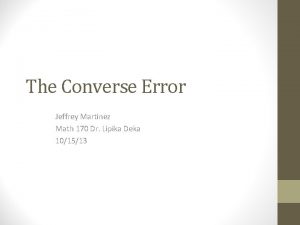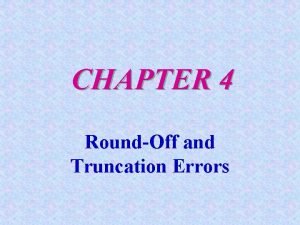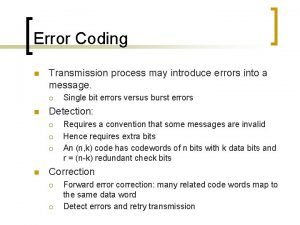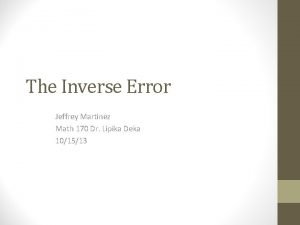The Converse Error Jeffrey Martinez Math 170 Dr




- Slides: 4

The Converse Error Jeffrey Martinez Math 170 Dr. Lipika Deka 10/15/13

Converse Error Also known as the fallacy of affirming the consequent (Epp p. 58). The converse error is a reasoning error that can be easily made, since in at least one case the conclusion can be true given the premises, but not in all cases. The premises present a given implication, and then state that the result of the implication or the consequent is true. This step is called affirming the consequent. The conclusion then states that since the consequent is true, the antecedent must be true. Although at first glance the argument looks valid, but can be soon shown invalid by using truth tables, or by counterexample. We see an example of this error in exercise #28 in section 2. 3 of our Discrete Mathematics and Applications textbook. We can see the problem on the next slide.

Section 2. 3 #28 Use symbols to write the logical form of each argument. If the argument is valid, identify the rule of inference that guarantees its validity. Otherwise, state whether the converse or the inverse error is made. 28. Premise #1: If there as many rational numbers as there are irrational numbers, then the set of all irrational numbers is infinite. Premise #2: The set of all irrational numbers is infinite ∴There as many rational numbers as there are irrational numbers. Solution: Symbolically the initial implication (Premise #1) is of the basic form If P, then Q, or P→Q, letting P = There as many rational numbers as there are irrational numbers. Q = The set of all irrational numbers is infinite. Premise #2 states that Q is true The conclusion states that P is true The simple answer is that the argument is invalid, because the converse error is made. But lets look at truth table to prove this answer.

Looking at the truth table below, we identify our premises. We look for instances when both our premises P → Q and Q are true. In the first row, our premises are true and our conclusion P is true. But in the third row we see that even though P → Q and Q are true, P is not true. P Q P→Q T T F F* F T T F F T *P → Q is only false when P is true, and Q is false. This means that Q could be true for some other reason unrelated to P, which is important to our solution. To state this as a counterexample, given the original implication “If there as many rational numbers as there are irrational numbers, then the set of all irrational numbers is infinite. ” The set of irrational numbers can be infinite, but could be considered infinite for reasons not pertaining to the amount of rational numbers at all. This argument WOULD be true if it was stated as: “The set of irrational numbers is infinite if and only if there as many rational numbers as there are irrational numbers. ” Otherwise, the conclusion is false, and the argument is invalid due to the converse error.







